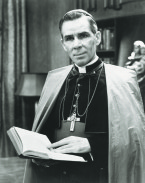
By Christopher White
The Tablet National Correspondent
The dispute over Archbishop Fulton J. Sheen’s body will advance yet another round next week when a New York court hears an appeal on Tuesday from the Archdiocese of New York in an effort to keep the remains in the city.
Archbishop Sheen was an American bishop who became one of the most well-known Catholic evangelists of the 20th century.
Born in 1895 in Illinois and ordained a priest in 1919 by the Diocese of Peoria, he received nationwide fame after moving to New York and hosting a television show, “Life is Worth Living.”
His broadcast would reach up to 30 million viewers each week, with only 40 percent of his audience being identified as Catholic.
Archbishop Sheen died at age 84 in 1979 and is buried in the crypt in Saint Patrick’s Cathedral in Manhattan.
In 2002, Bishop Daniel Jenky of Peoria initiated the canonization process on his behalf, which has been delayed over disputes about requests to return his body to the Diocese of Peoria.
Cardinal Timothy Dolan of New York has said it was the “personal wish of Archbishop Sheen to be permanently buried beneath the high altar of St. Patrick’s Cathedral.”
Family members of Archbishop Sheen disagree, resulting in a much-publicized legal tug-of-war over his body.
In November 2016, his closest living relative, his niece Joan Sheen Cunningham, petitioned the courts for his body to be returned to Illinois. The New York Supreme Court sided with Cunningham, but the Archdiocese of New York appealed the decision.
In a letter sent on Wednesday to the members of the Peoria diocese, Bishop Jenky said, “I strenuously request for your prayers for the Appellate Court to side in favor of Joan’s petition.
“A favorable ruling supporting Joan’s petition will be a great step towards bringing (Archbishop) Sheen to Peoria and advancing his beatification,” Bishop Jenky added.
In 2012, Pope Benedict XVI recognized Archbishop Sheen for possessing “heroic virtues” and gave them the title of “Venerable.”
In June 2014, a panel of theologians that advises the Congregation for the Causes of Saints ruled that a stillborn baby’s recovery after having no pulse for an hour after birth was miraculous, and due to the intercession of the former Archbishop. This means Archbishop Sheen’s beatification would presumably happen shortly after the cause is re-opened.
There is a long, historical tradition of disputes between dioceses over the disposition of the remains of saints. The most famous example is arguably that of St. Catherine of Siena, who was decapitated so that her head and hand could be sent to Siena while the rest of her body remained in Rome, at the Church of Santa Maria Sopra Minerva.
Most dioceses are eager to push for the canonization of potential saints affiliated with their particular diocese as they become popular sites for pilgrimages, yielding both spiritual and financial benefits.
Until the dispute over Archbishop Sheen’s body can be resolved, his cause for canonization will remain indefinitely suspended.
